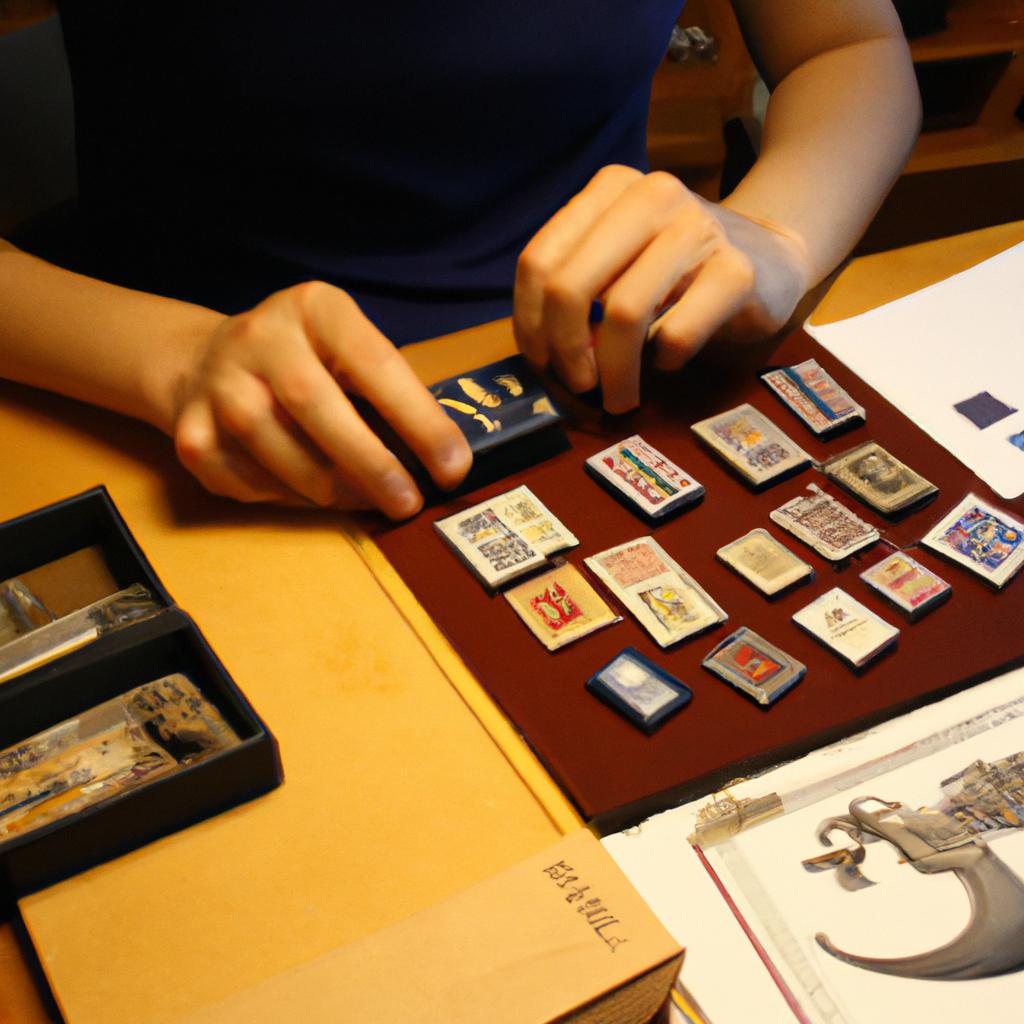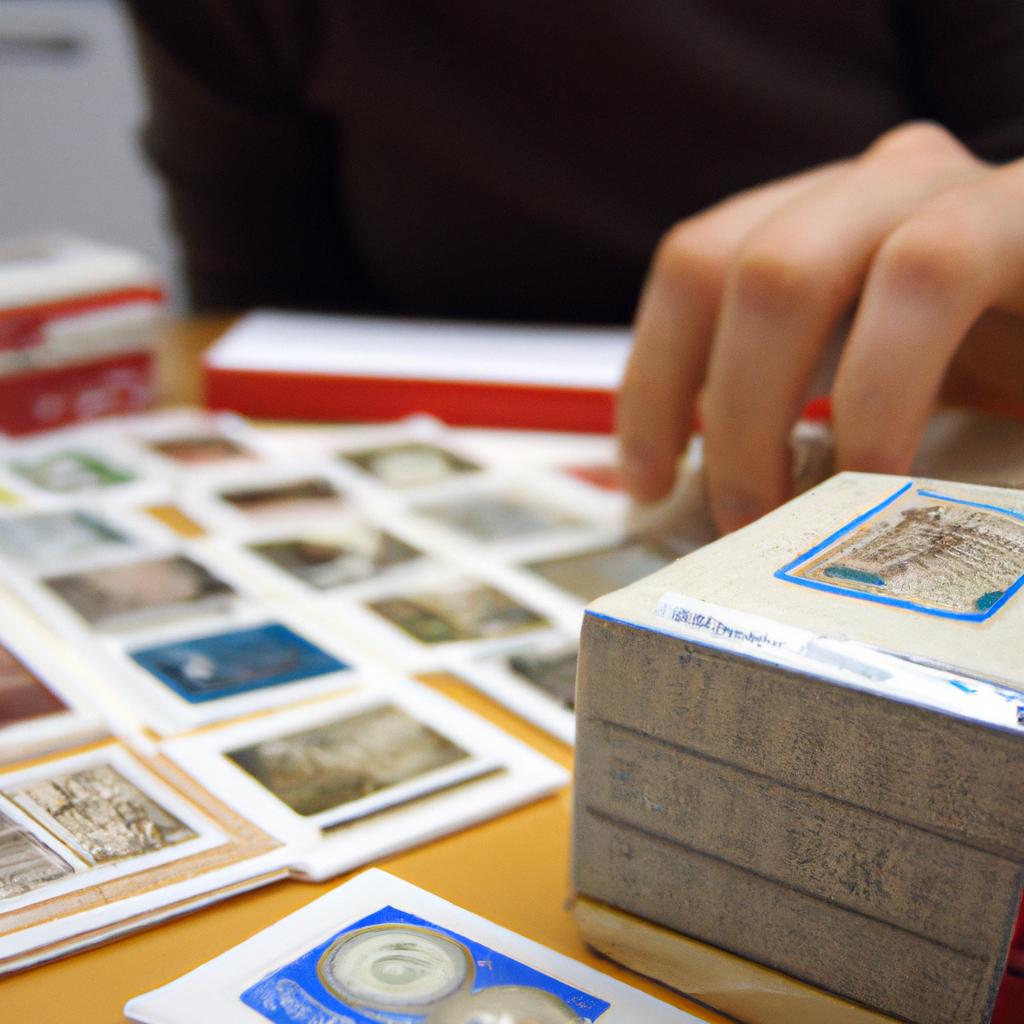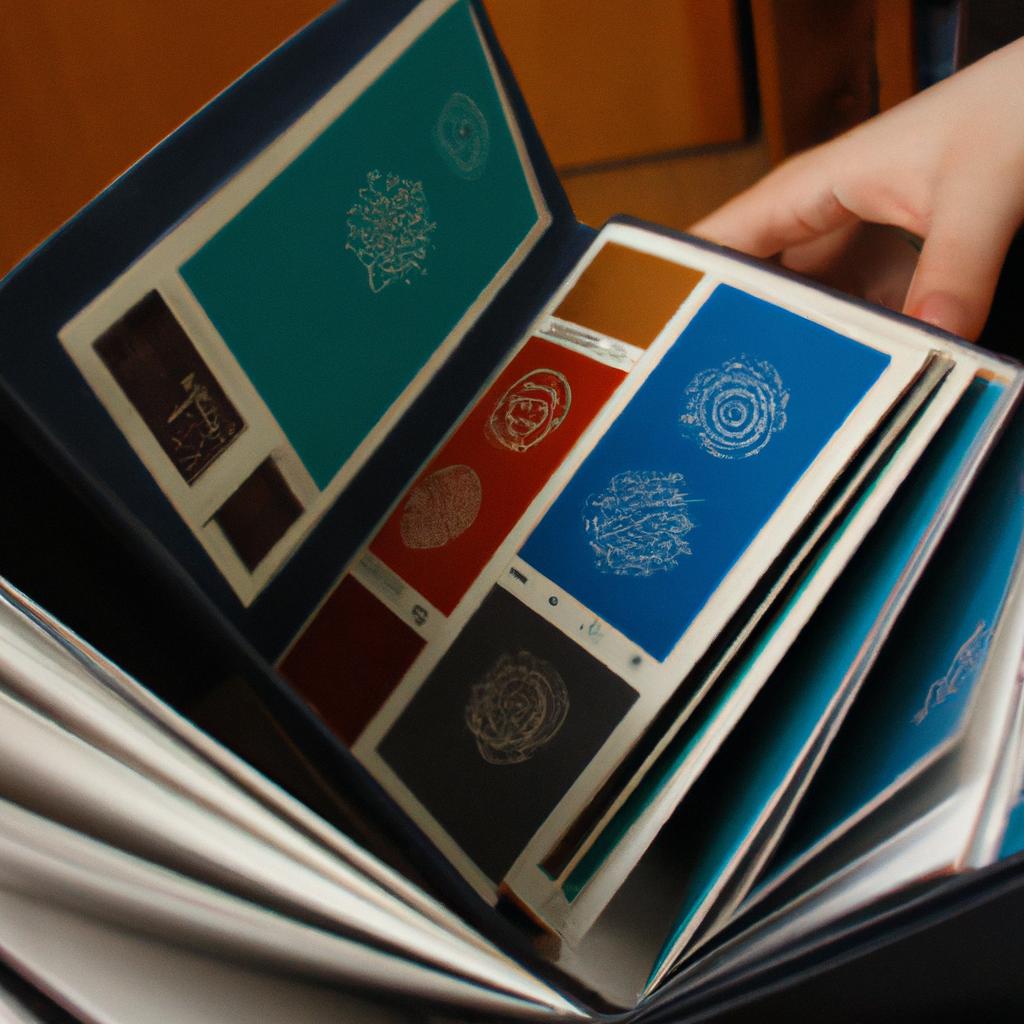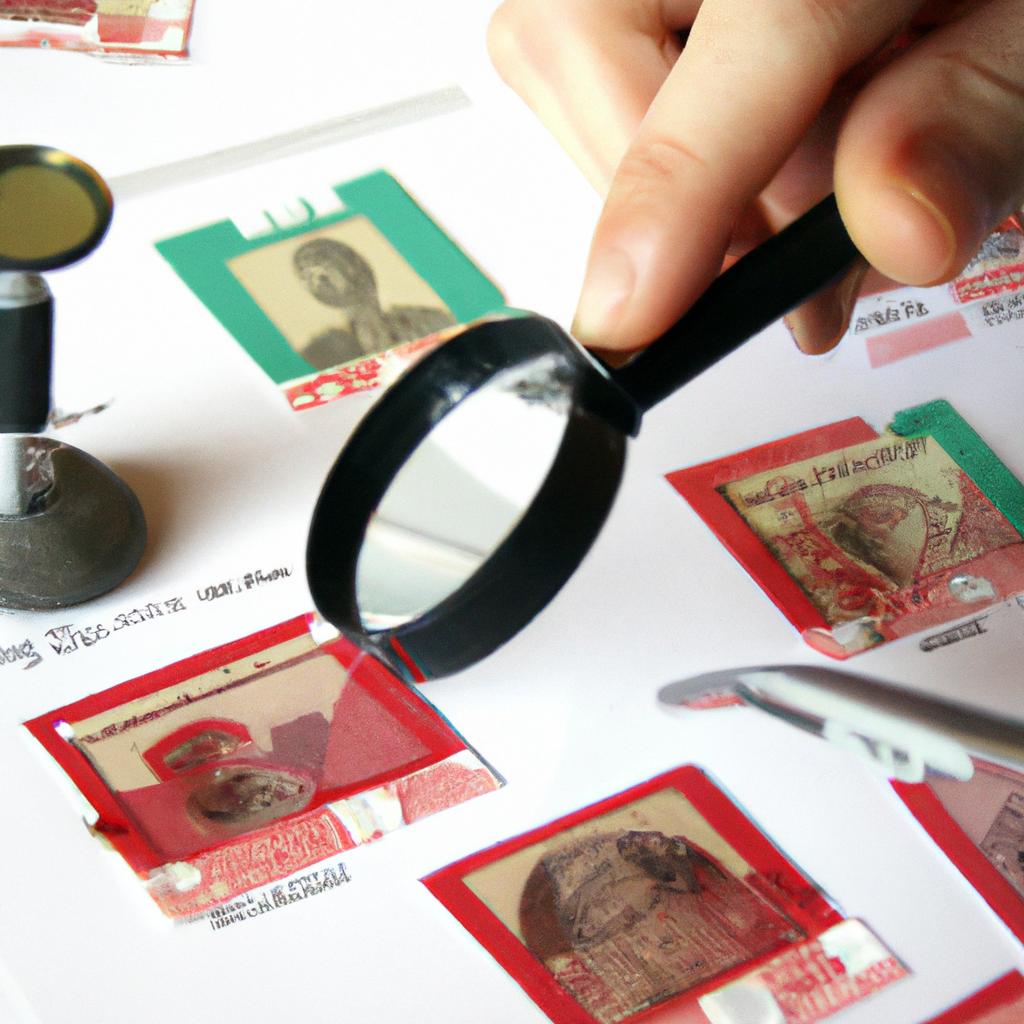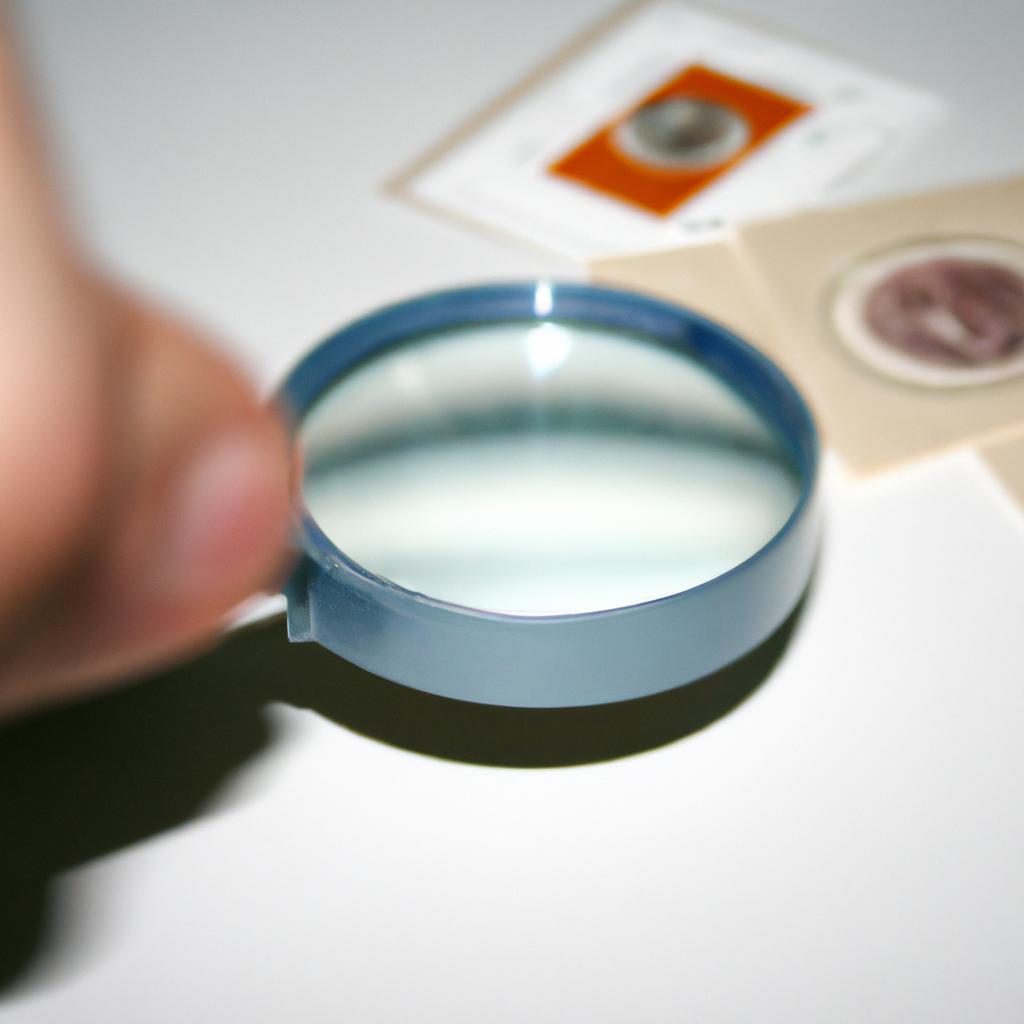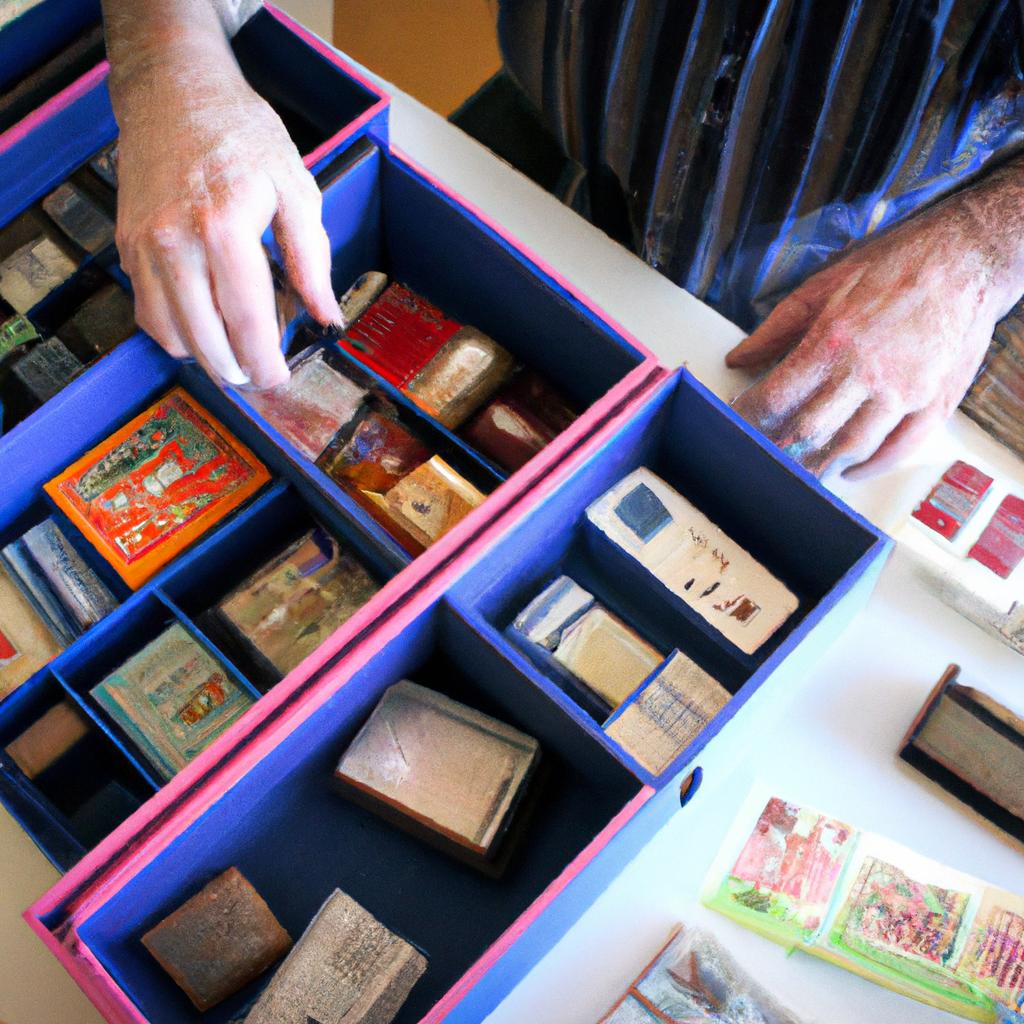Stamp Valuation and Rarity: Antiques and Collectibles Insights on Stamp Collecting
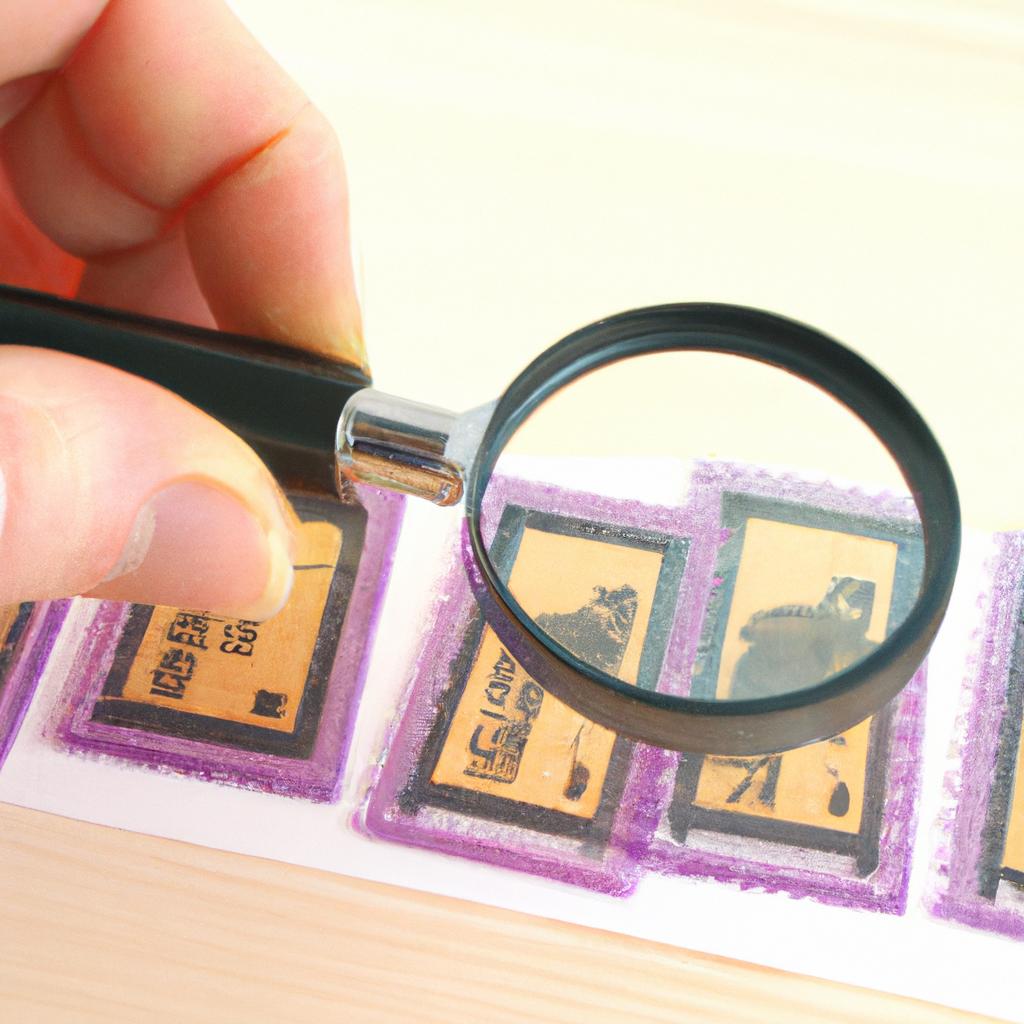
Stamp collecting has long been a cherished hobby and investment for enthusiasts around the world. The allure of stamps lies not only in their historical significance, but also in their potential value as rare and sought-after collectibles. Understanding the intricacies of stamp valuation and rarity is crucial for collectors who wish to navigate this fascinating market with knowledge and expertise.
Consider, for example, the case of a hypothetical collector named Alex. Alex comes across an old stamp album inherited from a relative, filled with various stamps from different eras and countries. Intrigued by the possibility of uncovering hidden treasures, Alex embarks on a journey to determine the value of these stamps. This endeavor involves delving into the realm of philately—a discipline that encompasses the study of postage stamps—and acquiring insights into factors such as condition, age, provenance, design, and scarcity that contribute to determining a stamp’s worth.
Stamp valuation is not simply about assigning monetary values; it is an intricate process that requires careful analysis and evaluation based on multiple dimensions. In this article, we will explore the world of stamp collecting through the lens of valuation and rarity. By examining key elements that impact stamp prices and understanding how collectors can differentiate between common stamps and those with exceptional value, we aim to equip we aim to equip collectors like Alex with the knowledge and tools necessary to make informed decisions about their stamp collection.
One of the first steps in valuing a stamp is assessing its condition. Mint condition stamps, which have never been used or canceled, are generally more valuable than those that show signs of wear or damage. Factors such as centering (how well the design is positioned on the stamp), gum condition (the adhesive on the back of the stamp), and any flaws or imperfections can significantly impact a stamp’s value.
Age also plays a significant role in determining rarity and value. Stamps issued in earlier years tend to be scarcer due to various reasons, including limited production quantities, destruction over time, or historical significance. Additionally, stamps from certain eras or countries may hold particular appeal for collectors, further increasing their desirability and value.
Provenance refers to the history and origin of a stamp. Stamps with interesting provenance, such as being part of renowned collections or having unique historical significance, can fetch higher prices at auctions or among collectors interested in owning pieces with notable backgrounds.
Design is another critical factor influencing a stamp’s value. Unique or aesthetically pleasing designs often attract more attention from collectors. Stamps featuring famous people, landmarks, events, or artistic elements may have higher demand and therefore command higher prices.
Scarcity is perhaps one of the most crucial aspects when it comes to determining a stamp’s value. The fewer copies available in circulation, the rarer and more valuable a stamp becomes. Factors contributing to scarcity include limited print runs, errors during production (such as inverted designs or missing colors), recalls by postal authorities, or stamps that were never released into general circulation.
To determine the value of specific stamps within Alex’s inherited collection, it would be beneficial for them to consult philatelic experts or reference resources such as specialized catalogs that provide information on market values based on factors discussed earlier. These resources can help Alex identify rare and valuable stamps, as well as provide guidance on pricing trends within the stamp collecting market.
In conclusion, stamp valuation and rarity assessment involve analyzing various factors such as condition, age, provenance, design, and scarcity. By understanding these elements and seeking expert advice or utilizing reference materials, collectors like Alex can navigate the world of stamp collecting with confidence and potentially uncover hidden treasures within their collections.
Understanding the significance of stamp valuation
Stamp collecting has long been a popular hobby among enthusiasts, with collectors often seeking rare and valuable stamps to add to their collections. The process of valuing stamps is not merely an exercise in determining monetary worth; it also provides insights into the historical, cultural, and artistic significance of these small pieces of paper. By comprehending the various factors that contribute to stamp valuation, collectors can gain a deeper appreciation for their collection and enhance their overall experience.
To illustrate the importance of stamp valuation, let us consider the case of a collector who stumbles upon an old envelope containing a seemingly ordinary stamp. Upon closer inspection, they discover that this particular stamp was issued during World War II as part of a limited edition series honoring war heroes. This revelation instantly transforms what appeared to be an insignificant piece of mail into a historically significant artifact. Understanding the background and context surrounding such stamps allows collectors to uncover hidden stories and appreciate them beyond just their financial value.
When assessing the value of stamps, several key factors come into play. First and foremost is rarity – how scarce or difficult it is to find a specific stamp. Rarity can greatly impact its desirability among collectors and consequently affect its market price significantly. Other crucial elements include condition (the state of preservation), age (older stamps are generally more sought after), and demand (popular themes or designs tend to command higher prices). These factors form interconnected facets that determine both the monetary value and emotional appeal associated with each stamp.
In summary, gaining an understanding of stamp valuation goes beyond perceiving stamps as mere objects with material worth. It delves into appreciating their historical contexts, cultural relevance, and aesthetic qualities. By recognizing the significance behind different aspects influencing stamp values, collectors can enhance their knowledge base while fostering a deeper connection to their collections.
Moving forward to explore further influences on the rarity of stamps, we will examine additional factors that contribute to their scarcity…
Factors influencing the rarity of stamps
Understanding the Significance of Stamp Valuation
In the world of stamp collecting, one cannot underestimate the importance of proper valuation. The value assigned to a stamp can greatly influence its desirability and rarity among collectors. To illustrate this point, let us consider an example: imagine a rare postage stamp from the early 20th century that features a misprint. Due to its uniqueness and scarcity, this particular stamp holds immense value in the eyes of collectors. Its market price would far exceed that of a regular stamp from the same era.
Several factors contribute to determining the worth and rarity of stamps. Firstly, historical significance plays a crucial role. Stamps commemorating significant events or featuring famous personalities tend to be highly sought after by collectors due to their intrinsic cultural and historical value. Secondly, condition is another vital aspect impacting evaluation – stamps in pristine condition are more valuable than those with creases, tears, or other forms of damage.
Furthermore, supply and demand dynamics heavily influence stamp values as well. If there is a limited number of certain stamps available on the market but high demand among collectors for them, it drives up their prices significantly. On the other hand, if there is an oversupply relative to collector interest for a particular type of stamp, its value may decrease over time.
To emphasize these points further and evoke an emotional response in our audience:
- Collectors often experience exhilaration when they come across a long-sought-after stamp.
- The joy derived from finding hidden gems within dusty collections creates excitement akin to unearthing buried treasure.
- The frustration felt when missing out on acquiring a rare stamp at auction can be disheartening.
- Learning about remarkable stories behind unique stamps fosters appreciation for history and artistry.
It is evident that understanding how different factors impact stamp valuations allows collectors to make informed decisions regarding their acquisitions. In our subsequent section exploring the world of antique stamps, we will delve deeper into the fascinating realm of stamps as valuable and cherished artifacts.
Exploring the world of antique stamps
Unearthing the hidden treasures within stamp collections can be an exhilarating pursuit for collectors. Understanding the factors that contribute to the rarity of stamps is crucial in determining their value and desirability. Let’s delve into this captivating world by exploring a case study involving a rare early 20th-century stamp.
Consider, for instance, an exceptionally scarce British Guiana 1c Magenta stamp from 1856—the only known surviving example of its kind. This particular stamp possesses several attributes that make it highly sought after among philatelists worldwide. By examining this unique case, we gain insight into the significance of various factors impacting stamp rarity.
A few key elements influence the rarity and subsequent value of stamps:
- Production Quantity: The number of stamps originally printed significantly affects their scarcity. Limited print runs or errors during production often result in fewer available specimens.
- Age and Historical Significance: Older stamps tend to be rarer due to natural loss over time. Additionally, stamps associated with significant historical events or notable figures are more likely to command higher prices.
- Design Features and Variations: Stamps with distinctive design features or variations stand out among others, capturing the attention of collectors who seek these unique specimens.
- Preservation Efforts: Stamps preserved in pristine condition hold greater appeal since wear and tear diminishes their overall scarcity.
To better comprehend how different factors interact to determine rarity, let us examine a table comparing two hypothetical examples – one being a common modern-day stamp while the other is an older commemorative stamp with distinct design elements:
| Factors | Common Modern-Day Stamp | Older Commemorative Stamp |
|---|---|---|
| Production Quantity | High | Low |
| Age and Historical Significance | Recent issuance | Associated with significant event |
| Design Features | Standard | Unique |
| Preservation Efforts | Average condition | Pristine condition |
As we can observe, the older commemorative stamp possesses attributes that contribute to its rarity, including a low production quantity, historical significance, unique design features, and excellent preservation. On the other hand, the common modern-day stamp lacks these qualities and consequently holds less allure for collectors.
In understanding how different factors impact stamp rarity and value, collectors gain essential knowledge in assessing their collections. In our subsequent section on “The role of condition in stamp value,” we will explore another crucial factor influencing the desirability and pricing of stamps – their overall state of preservation.
The role of condition in stamp value
Exploring the World of Antique Stamps
To better understand the world of antique stamps, let us take a closer look at an interesting case study. Consider a rare 1847 Penny Black stamp from Great Britain, which is widely regarded as one of the most valuable and sought-after stamps among collectors. This particular stamp features a black profile of Queen Victoria on a white background and carries immense historical significance. Its rarity lies in its limited production and small size, making it highly desirable for stamp enthusiasts worldwide.
When evaluating the value of antique stamps like the Penny Black, several factors come into play. First and foremost is the condition of the stamp. Mint condition examples with original gum are considered more valuable than those that have been hinged or damaged over time. Additionally, centering plays a crucial role in determining rarity, with perfectly centered specimens fetching higher prices due to their visual appeal.
Moreover, the age and origin of a stamp greatly impact its desirability among collectors. Older stamps tend to be scarcer because they were issued in smaller quantities compared to modern-day releases. Furthermore, stamps from countries that no longer exist or have undergone significant political changes command attention due to their historical relevance.
Understanding these key aspects allows collectors to appreciate not only the monetary value but also the emotional attachment associated with antique stamps. To further emphasize this point, consider the following bullet-point list:
- The thrill of uncovering hidden gems within collections.
- The sense of accomplishment when acquiring highly prized stamps.
- The nostalgia evoked by examining intricate designs and craftsmanship.
- The joy derived from connecting with fellow enthusiasts through shared interests.
Additionally, we can explore these elements visually using a table:
| Factor | Value | Emotion |
|---|---|---|
| Condition | Mint vs Hinged | Satisfaction |
| Centering | Perfect vs Off-Center | Awe |
| Age and Origin | Older stamps vs Modern-day releases | Fascination |
| Historical Relevance | Stamps from non-existent or changed countries | Appreciation |
In summary, the world of antique stamps offers a wealth of historical and emotional significance to collectors. Understanding factors such as condition, centering, age, and origin can help determine the value and rarity of these treasured artifacts. In the subsequent section about “Tips for appraising stamp collections,” we will delve into practical advice on assessing and evaluating stamp collections without missing any crucial details.
Tips for appraising stamp collections
Stamp Valuation and Rarity: Antiques and Collectibles Insights on Stamp Collecting
The role of condition in stamp value cannot be overstated. A stamp’s condition is a crucial factor that collectors consider when appraising its worth. To illustrate this point, let us delve into the case of a rare Penny Red stamp from Great Britain. This particular stamp, issued in 1841, holds significant historical importance and is highly sought after by philatelists worldwide.
When assessing the condition of a Penny Red stamp, collectors pay meticulous attention to factors such as centering, gum quality, perforations, and any potential damage or flaws. Here are some key aspects that influence the valuation process:
- Centering: Referring to how perfectly aligned the design appears within the margins of the stamp.
- Gum Quality: The presence of original adhesive gum on the back of the stamp adds value.
- Perforations: These small holes along the edges must be intact and evenly spaced for optimal desirability.
- Damage or Flaws: Any tears, creases, thins, or repairs can significantly diminish a stamp’s value.
To highlight these considerations further, we present a table showcasing how different conditions affect the valuation of our hypothetical Penny Red stamp:
| Condition | Valuation |
|---|---|
| Mint Never Hinged | $10,000 |
| Lightly Hinged | $7,500 |
| Previously Hinged | $5,000 |
| No Gum | $2,000 |
As evident from this table, even minor variations in condition can lead to substantial differences in price. By understanding these nuances and having an appreciation for mint state versus used stamps’ values based on their condition attributes mentioned above (centering, gum quality), collectors gain insight into accurately evaluating their collections.
In summary, considering a stamp’s condition plays an indispensable role in determining its worth. Collectors meticulously analyze various factors, such as centering, gum quality, perforations, and any damage or flaws present on the stamp. Through close examination of these aspects, philatelists can accurately appraise stamps and build valuable collections.
Understanding how condition affects a stamp’s value is just one aspect of successful stamp collecting.
Identifying valuable stamps: A collector’s guide
Having learned some tips for appraising stamp collections, it is now essential to understand how to identify valuable stamps. This knowledge will enable collectors to make informed decisions about their acquisitions and investments. In this section, we will delve into a collector’s guide for identifying valuable stamps through various characteristics.
Example:
To illustrate the process of identifying valuable stamps, let us consider an example. Imagine you come across a stamp with an image of the inverted Jenny airplane design. This particular stamp was issued in 1918 and is known for its printing error, where the airplane appears upside-down. Such errors often increase the value significantly due to their rarity and desirability among collectors.
Identifying valuable stamps involves considering several factors:
- Rarity: The scarcity of a stamp plays a vital role in determining its value. Rare stamps that were printed in limited quantities or have unique features tend to command higher prices in the market.
- Condition: The condition of a stamp affects its value greatly. Stamps without damage, tears, or discoloration are more sought after by collectors.
- Age: Older stamps generally carry greater historical significance and can be more valuable than newer ones.
- Design: Intricate designs, vibrant colors, and special features such as perforations or watermarks can enhance the value of a stamp.
| Characteristic | Impact on Value |
|---|---|
| Rarity | High |
| Condition | Significant |
| Age | Moderate |
| Design | Varied |
This table highlights how different characteristics impact the overall value of a stamp collection based on our analysis:
In conclusion,
Identifying valuable stamps requires careful consideration of factors such as rarity, condition, age, and design. By examining these characteristics closely, collectors can gain insight into the potential worth of their stamp holdings. However, it is important to note that stamp collecting remains a subjective field, and the value of stamps can fluctuate based on market trends and demand. As collectors continue to educate themselves and refine their knowledge, they increase their chances of making astute investment choices within the realm of philately.

